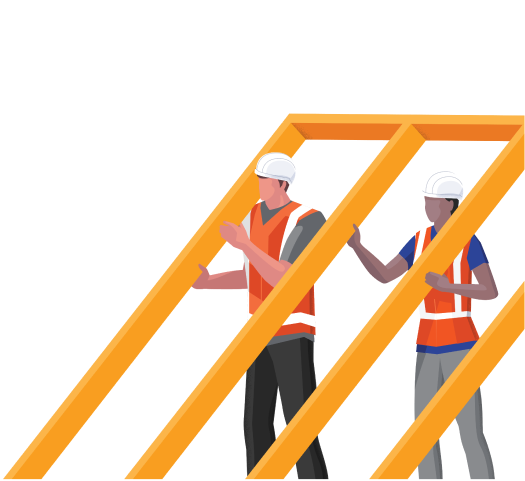— 10 min read
Construction Contract Documents: 9 Key Components
Last Updated Apr 15, 2024

Every construction project — whether a small-scale residential renovation or an extensive municipal development — requires a contract. Construction contracts are multifaceted, often comprising numerous documents that cumulatively define the scope, cost, schedule, quality, and conditions of the work to be performed.
This article will break down the typical components of a construction contract, as well as offering some best practices for those looking to enter into one of these important agreements.
Table of contents
What are construction contract documents?
On a construction project, the contract documents are the collection of documents that describe the scope, schedule, cost, and the responsibilities of each party to the agreement. The scope delineates the breadth and depth of work, the schedule frames the timeline for completion, and the cost dictates the financial parameters within which the project operates.
On a typical construction job, the contract is much more than a single document or sheet of paper. On a complex project, the suite of contract documents can easily run into the thousands of pages. When people refer to "the contract," they are technically referring to the entire group of documents that form the agreement.
A construction contract transitions from just a set of plans to an actionable directive, guiding parties through all of the nuances of what will be built and how it’s built from groundbreak to closeout. This signed agreement is more than a handshake -- it is a binding commitment that holds each party accountable to their promises, ensuring that the project advances from concept to concrete reality within the agreed-upon framework.
9 Essential Contract Documents
In general, there are nine types of documents that make up the construction contract. These may not always be separate documents -- on smaller projects, some details may be included in the agreement itself.
1. The Agreement
The construction agreement spells out the agreed-upon total price for the project and lays down the foundational terms that will govern the entire construction process. This is the document with "the dotted line:" the one page that both parties to the agreement actually sign (though other pages will often require both parties to initial them).
The signed agreement will reference the other documents and addendums that both parties are bound to by signing the agreement. Even though a contractor doesn't physically sign the drawings, for example, they are "incorporated by reference."
Depending on the financial strategy chosen for the project — be it a lump sum where a single fixed price covers all labor and materials, a cost-plus contract that guarantees payment for all construction expenses plus profit, or a time and materials contract that pays for the labor and materials used — the form of the agreement will adapt accordingly.
It's within this central agreement that the essential deal between the client and contractor is struck, forming the basis from which all subsequent project details — such as scope and schedule — are defined and developed. This document doesn't just outline what payments are made and when; it sets the stage for how the project will unfold, influencing every aspect from kickoff to completion.
2. General Conditions
The general conditions are a common addendum to a contract. They act as the rulebook for the execution and management of a construction project. They encompass a broad range of terms that dictate the fundamental procedural guidelines and establish the rights and obligations of the parties involved.
Key areas covered by general conditions typically include project administration, the responsibilities of the owner and contractor, guidelines for submittals, procedures for change orders, and protocols for payment applications. They also lay out requirements for insurance and bonds, provide instructions for conflict resolution, and set terms for potential project termination.
Furthermore, general conditions address the contractor's operational scope, including the provision of a site superintendent, project management and the handling of on-site conditions such as security and safety measures.
3. Special Conditions
The special conditions describe the custom-fit elements that cater to a project's unique aspects — those that require attention beyond what the general conditions cover. These might range from environmental sustainability features — like green building standards — to specific safety protocols unique to the project's nature or location. They could also include details on how the site will be managed day-to-day, ensuring materials and personnel flow smoothly.
These conditions are typically appended to the General Conditions and serve to fine-tune the contract by addressing the nitty-gritty that makes each construction project different. Whether it's dealing with particular site security measures, managing traffic during construction, or adhering to local regulations, Special Conditions provide a tailored approach to project specifics. In addition to these, various third-party reports and due diligence findings may also influence budget considerations and, consequently, are often integral to the contract documents.
4. Scope of Work
The scope of work serves as a detailed narrative describing the work that needs to be performed as part of the project. These documents are central to defining the extent of a project's requirements and outline the tasks and objectives for each involved party, such as contractors and subcontractors.
On smaller projects the scope of work may be a section of the agreement form. Larger, complex projects will often describe the scope in a separate document that is referenced in the agreement.
The scope of work is usually broken down into smaller chunks using a Work Breakdown Structure — specifying the materials to be used, the standards of workmanship expected, the equipment needed for installation and other operational details. Essentially, it informs the contractors not only what needs to be constructed but also how it should be done, including performance criteria and quality of the end result.
5. Construction Drawings
The drawings serve as a crucial visual representation of the project, offering essential details and dimensions of the desired end result. Drawings communicate the architect's intent for the project. These drawings are instrumental in guiding the construction work effectively.
Architects produce a variety of drawing types to illustrate details of the work from different perspectives and for different trade specialties or systems. On large projects, the drawings can easily reach thousands of pages.
6. Specifications
Specifications, or "specs," contain the project's technical data, material requirements and construction methods, setting quality standards for the work. They complement the construction drawings in describing detailed project attributes and ensuring adherence to industry standards.
In construction, the specifications are often organized according to MasterFormat or CSI divisions, with each section of the spec book detailing the materials and methods for particular scopes of work.
7. The Schedule
The construction schedule outlines the project's timeline and phases, providing a detailed sequence of activities and establishing critical milestones that guide the project's progression. This contract document is more than a plan — it's a commitment to project timing and serves as a gauge for measuring project health and efficiency.
For big and complicated jobs, using detailed planning methods like the Critical Path Method (CPM) can help clearly outline important tasks and when they depend on each other. Like most aspects of construction management, the schedule requires regular check-ups and tweaks to keep up with the real work being done and to handle any surprises along the way.
The schedule serves as a guide to keep the project moving in the right direction, as long as it’s up-to-date. Everyone involved stays in the loop about where things stand. Including a detailed schedule in the contract documents requires that any schedule updates be made through a formal change order or contract amendment process. Monthly updates are often required as a contract stipulation to also safeguard against any schedule disputes arising from a project scheduling running away from you so to speak.
8. Schedule of Values
The contract value is broken down into a schedule values (SOV), an itemized list of work segments with the corresponding value of each one. Throughout the project, the contractor will typically prepare a continuation sheet to show the percentage of each work item that is complete based on the expenditures for each category.
This statement is pivotal to the payment process, as it outlines the distribution of the total sum for different tasks and materials throughout the project's duration.
9. Bill of Quantities
The bill of quantities serves as a predictive tool, providing an itemized forecast of materials, labor, and other costs associated with the project. It allows contractors to prepare accurate bids and facilitates the client in evaluating these bids more efficiently. The document's precision in detailing quantities and costs is instrumental in providing transparency and helping manage the financial expectations of both the client and the contractor.
Make it easier to manage construction.

Best Practices for Managing Contract Documents in Construction
There are a few best practices that can aid in managing contract documents effectively on a construction project.
Create a clear document hierarchy.
Implement an order of precedence clause in the agreement to establish a clear hierarchy among the contract documents. This clause is vital for resolving discrepancies, ensuring there is a predefined sequence determining which document prevails in the face of conflicting information.
Adopt a comprehensive document management system.
Use a robust system to oversee the evolving nature of contract documents throughout negotiations and the construction process. Such a system should be capable of tracking revisions, managing approvals efficiently, and ensuring all parties are working from the most updated documents available.
Keep documents current and comprehensive.
Before starting a job, ensure a system is in place to continually update all contract documents, especially schedules and technical specifications. It's essential to monitor revisions diligently and communicate updates across all project stakeholders to maintain clarity and continuity.
Implement defined change order processes.
Contracts will likely go through a few or even several revisions before being executed. Keep accurate records and evidence of all communications , both verbal and non-verbal to ensure all is included or reflected in the contract. Having a formal process in place for proposing, documenting, and approving any changes. A structured approach to managing change orders will help maintain control and understanding over the project's scope, budget, and schedule. By sticking to these practices, you can enhance the efficiency and clarity of contract document management, contributing to the smooth execution and successful completion of construction projects.
After signing, reference the contract docs.
In construction, change is inevitable. In order to quickly and accurately identify changes, make it a regular practice to reference and check the contract docs for alignment. This means during the course of construction, be sure to review RFIs, submittals, change orders for alignment with your contract documents and agreements.
Contracts: More Than a Signature
A construction contract is more than just a legal formality; it guides the entire construction process from start to finish. And, when everyone involved in a project has a good understanding of what is included in the contract documents, it ensures that all parties are aligned with the project objectives and will minimize disputes during the course of construction.
Utilizing technology to organize documents and communicate with the other parties will optimize the negotiation process leading up to a signed and fully executed construction contract, leading to overall project success for all project team members.
Categories:
Tags:
Written by
Janine Trinidad
13 articles
Janine Trinidad is a Senior Trainer on the Construction Education team at Procore. In previous roles, Janine managed preconstruction, construction, and turnover on hotel, mixed-use, and institutional projects in the San Francisco Bay area. She was responsible for negotiating contract budgets and change orders, managing RFIs and submittals, and overseeing quality control, among many other project duties. She is also a certified yoga instructor and performance artist. She currently lives in San Diego.
View profileDavid Giali
David is a Content Marketing Associate at Procore. He is an experienced writer in the software industry with close to 1000 published articles. Before writing, he worked in for a specialty contractor as an estimator and finish contractor. David spends his time outdoors with his wife and dog, experimenting with film photography, and writing music.
View profileWin More Work
Get discovered for relevant work on the Procore Construction Network.

Explore more helpful resources

Contract Precedence: A Clause to Clear Construction Confusion
Construction contracts are usually lengthy and complicated, composed of a wide range of documents In a perfect world, the contract provides the clarity and direction all stakeholders need to move...

Construction Contract Administration: Roles & Responsibilities
Construction contracts, especially for large projects, can be extremely detailed with many key documents often compiling thousands of pages. Because of this, larger firms have a dedicated role to keep...

Job Order Contracting (JOC) Explained
Contracts for commercial construction projects usually cover a complete scope of work, but large institutions often have ongoing needs for smaller projects. This is where job order contracting (JOC) comes...

The AIA A201 Explained for Contractors & Owners
Before beginning a project, owners, architects and contractors need to define and agree upon their relationship to each other, so that everyone’s expectations can be met. The AIA document A201...
